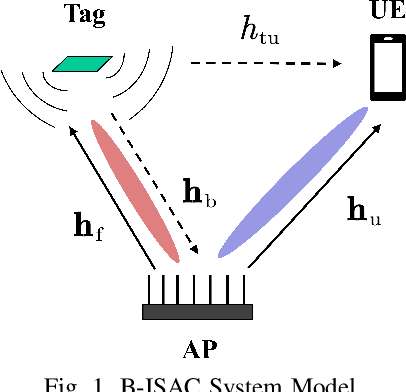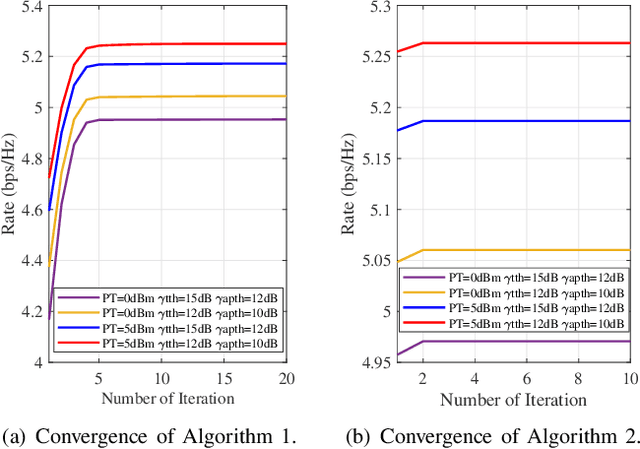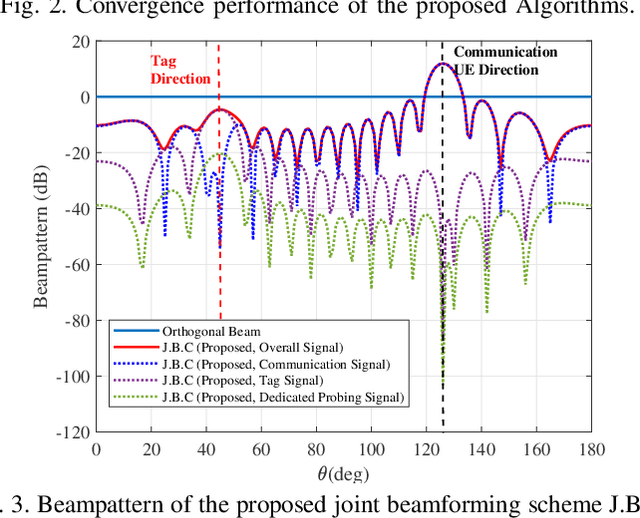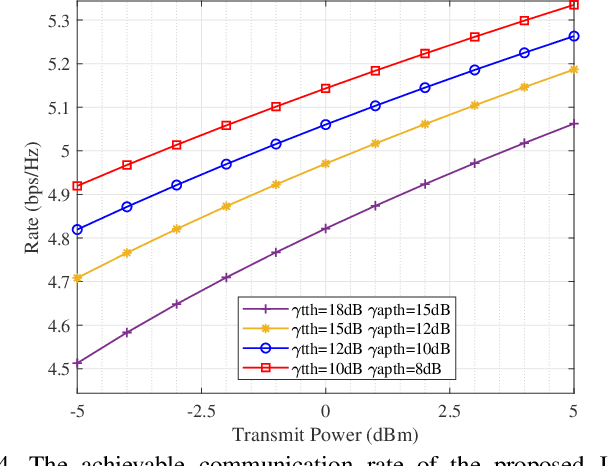Zongyao Zhao
Bayesian Beamforming for Integrated Sensing and Communication Systems
Feb 10, 2025Abstract:The uncertainty of the sensing target brings great challenge to the beamforming design of the integrated sensing and communication (ISAC) system. To address this issue, we model the scattering coefficient and azimuth angle of the target as random variables and introduce a novel metric, expected detection probability (EPd), to quantify the average detection performance from a Bayesian perspective. Furthermore, we design a Bayesian beamforming scheme to optimize the expected detection probability under the limited power budget and communication performance constraints. A successive convex approximation and semidefinite relaxation-based (SCA-SDR) algorithm is developed for the complicated non-convex optimization problem corresponding to the beamforming scheme. Simulation results show that the proposed scheme outperforms other benchmarks and exhibits robust detection performance when parameters of the target are unknown and random.
Joint Beamforming for Multi-target Detection and Multi-user Communication in ISAC Systems
Nov 01, 2024Abstract:Detecting weak targets is one of the main challenges for integrated sensing and communication (ISAC) systems. Sensing and communication suffer from a performance trade-off in ISAC systems. As the communication demand increases, sensing ability, especially weak target detection performance, will inevitably reduce. Traditional approaches fail to address this issue. In this paper, we develop a joint beamforming scheme and formulate it as a max-min problem to maximize the detection probability of the weakest target under the constraint of the signal-to-interference-plus-noise ratio (SINR) of multi-user communication. An alternating optimization (AO) algorithm is developed for solving the complicated non-convex problem to obtain the joint beamformer. The proposed scheme can direct the transmit energy toward the multiple targets properly to ensure robust multi-target detection performance. Numerical results show that the proposed beamforming scheme can effectively increase the detection probability of the weakest target compared to baseline approaches while ensuring communication performance.
Joint Beamforming for Backscatter Integrated Sensing and Communication
Sep 04, 2024



Abstract:Integrated sensing and communication (ISAC) is a key technology of next generation wireless communication. Backscatter communication (BackCom) plays an important role for internet of things (IoT). Then the integration of ISAC with BackCom technology enables low-power data transmission while enhancing the system sensing ability, which is expected to provide a potentially revolutionary solution for IoT applications. In this paper, we propose a novel backscatter-ISAC (B-ISAC) system and focus on the joint beamforming design for the system. We formulate the communication and sensing model of the B-ISAC system and derive the metrics of communication and sensing performance respectively, i.e., communication rate and detection probability. We propose a joint beamforming scheme aiming to optimize the communication rate under sensing constraint and power budget. A successive convex approximation (SCA) based algorithm and an iterative algorithm are developed for solving the complicated non-convex optimization problem. Numerical results validate the effectiveness of the proposed scheme and associated algorithms. The proposed B-ISAC system has broad application prospect in IoT scenarios.
B-ISAC: Backscatter Integrated Sensing and Communication for 6G IoE Applications
Jul 27, 2024Abstract:The integration of backscatter communication (BackCom) technology with integrated sensing and communication (ISAC) technology not only enhances the system sensing performance, but also enables low-power information transmission. This is expected to provide a new paradigm for communication and sensing in internet of everything (IoE) applications. Existing works only consider sensing rate and detection performance, while none consider the estimation performance. The design of the system in different task modes also needs to be further studied. In this paper, we propose a novel system called backscatter-ISAC (B-ISAC) and design a joint beamforming framework for different stages (task modes). We derive communication performance metrics of the system in terms of the signal-to-interference-plus-noise ratio (SINR) and communication rate, and derive sensing performance metrics of the system in terms of probability of detection, estimation error of linear least squares (LS) estimation, and the estimation error of linear minimum mean square error (LMMSE) estimation. The proposed joint beamforming framework consists of three stages: tag detection, tag estimation, and communication enhancement. We develop corresponding joint beamforming schemes aimed at enhancing the performance objectives of their respective stages by solving complex non-convex optimization problems. Extensive simulation results demonstrate the effectiveness of the proposed joint beamforming schemes. The proposed B-ISAC system has broad application prospect in sixth generation (6G) IoE scenarios.
 Add to Chrome
Add to Chrome Add to Firefox
Add to Firefox Add to Edge
Add to Edge